| h | |
蒲松龄作品被美国一出版公司侵权近百年
| |
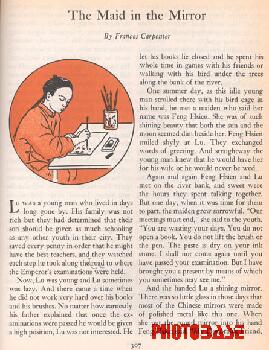
人民网9月3日电 山东省儿童文学家邱勋先生日前在家中向记者披露:他在研究美国童话时发现,美国大学学会出版公司出版的已畅销近百年的《少男少女丛书》,剽窃了蒲松龄两篇作品。记者与淄川区蒲松龄纪念馆副馆长、蒲松龄第11世孙蒲章俊联系,蒲章俊说还不清楚此事。
邱勋拿出从美国带回的美国大学学会出版公司出版的《THE BOOKSHELF FOR BOYS & GIRLS(少年少女丛书)》第三卷《FOLK AND FAIRY TALES(童话故事卷)》和《聊斋志异》比较,发现其中的《The Wonderful Pear Tree(奇妙的梨树)》无论从故事还是人物、主要情节和细节,与蒲松龄的《种梨》几乎完全相同。另一篇是《The Maid in the Mirror(镜中少女)》。它不象前者那样完整剽窃,而是从《凤仙》中挖出一段重要情节,独立成篇。连人物名字也未改,男名“Lu(刘)”,女名“Feng Hsien(凤仙)”。两篇文章作者署名都是Frances Carpenter。
据了解,美国大学学会出版公司(THE UNIVERSITY SOCIETY, INC.)于1909年就出版了《少年文库》,1912年改名为《少男少女丛书》。邱勋在美国发现美国许多家庭都有此书,他说他所见到的1970年版已是第20次印刷,目前还在再版。
山东大学博士生导师、蒲松龄研究专家马瑞芳教授说,早在十九世纪初,《聊斋志异》就有了美国传教士卫三畏的翻译本。现在《聊斋志异》的外文读本有20余种。像美国这家出版公司公开剽窃《聊斋志异》作品近百年的事实还很罕见,我们应该站出来澄清事实。
中国军事科学院军史部原副部长李维民,原省文化局(文化厅前身)局长、解放后担任蒲松龄著作编辑委员会主任的宋英先生闻听此事后都异常气愤。他们说,我们应该拿起法律武器还蒲松龄一个公道。
记者看到,剽窃的两文篇末都有一单词:Adapted(改编)。稍有出版常识的人都知道:改编的作品应该注明原作者,否则即侵权。何况《奇妙的梨树》是全文抄袭了《种梨》。大众报业集团法律中心负责人李毅律师认为,如果证据确凿,美国大学学会出版公司和Frances Carpenter最起码侵犯了蒲松龄的署名权。我国著作权法明确规定,作者本人的著作权保护期是作者终生及死后50年,但著作权中的人身权是不受保护期限制的,比如署名权、修改权、保护作品完整权。我国著作权法实施条例还规定,作者死后,著作的署名权、修改权和保护作品完整权,由作者的继承人或遗赠人保护,如果著作权无人继承又无人受遗赠的,其署名权、修改权、保护作品完整权由国家著作权行政管理部门保护。(逄春阶)
==========================================================================
相关背景: 《FOLK AND FAIRY TALES(童话故事卷)》中的《The Wonderful Pear Tree(奇妙的梨树)》,写的是中国的一个农村集市,一个农夫打扮的老人向卖梨者讨一只梨而不得,旁观者买一只赠之。老人吃罢,用锄头在地上挖个坑,把吃剩的梨核中的种子放进坑里,浇上讨来的一壶开水。眨眼间,地上冒出一片小绿芽,长成一棵小梨树。不一会儿梨树开花,结果,梨子成熟。老者将梨分赠大家。吃完以后,老者举起锄头将树挖倒,把它持作拐杖离去。卖梨者只顾看热闹,这时发现自己手推车上的两筐梨子全没了,方才明白老者是个农夫打扮的术士,他树上的梨原是自己车上的梨。急忙追赶,术士不见,只找到了他扔掉的树干拐杖,这才发现它是自己接在遮阳伞上的那根棍子。
这篇作品,故事、人物、主要情节和细节,与蒲松龄的《种梨》(参看上海古籍出版社“铸雪斋抄本”《聊斋志异》1979年版上卷P、15)完全相同。个别字句稍有不同,那是由于译者对中国国情不够了解出现的翻译上的不足和失误。此作真正的改动只有一处,那就是将著作者蒲松龄的名字改为:Frances Carpenter.
再是《The Maid in the Mirror(镜中少女)》。它不象前者那样完整剽窃,而是从《凤仙》(见上海古籍出版社"铸雪斋抄本"《聊斋志异》1979年版下卷第509页)中挖出一段重要情节,独立成篇。其内容是:刘姓少年遇美少女凤仙,后多次相会,柔情蜜意。但刘自此迷恋情人,荒疏学业。女赠一镜而去。刘回到书房,镜子里看到凤仙的身影。但她是背过身去的,总也不回过头来。刘自此起早睡晚,闭门谢客,刻苦攻读。再看镜子时,镜中少女凤仙朝自己微笑。后刘又故态复萌,厌烦读书,与朋友游荡玩耍。对镜一看,只见凤仙面颊上挂满了泪珠,背转身离他而去。刘心中难过,后悔,又开始起早睡晚刻苦用功。自此对镜苦读,几年后进京赶考,凯旋而归。凤仙自镜中下,嘱他答应一门婚事。花轿落地时,新娘正是凤仙。
这是蒲著《凤仙》中最精彩、最重要的一节。原作篇末异史氏曰:"少不努力,老大徒伤。惜无好胜佳人,作镜影悲笑耳。吾愿恒河沙数神仙人,并遣娇女婚嫁人间,则贫穷海中,少苦众生矣!"足见蒲公对这一段落的重视。Frances Carpenter先生这一刀很准,把《凤仙》的精髓挖出来并掠为己有了。连人物名字也未改,男名"Lu(刘)",女名"Feng Hsien(凤仙)"。只是把著作者的名字改为Frances Carpenter。
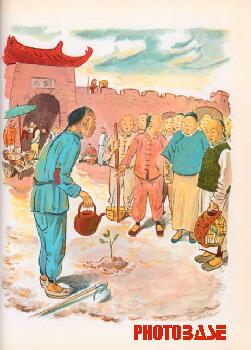
文中插画
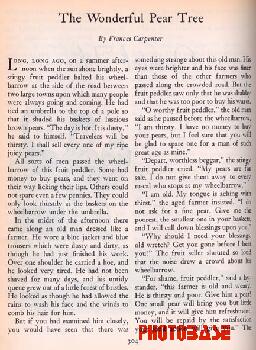
抄袭《种梨》的《The Wonderful Pear Tree(奇妙的梨树)》
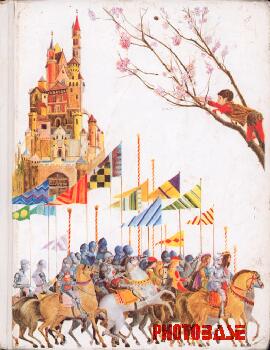
文中插画
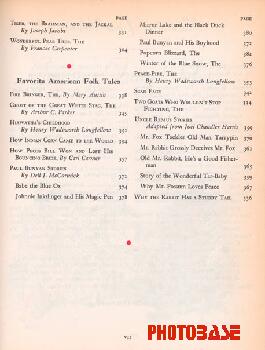
作品目录
(责任编辑:陈健)
==========================================================================
Works of Pu Songling Plagiarized
by US Publishing Company for a Century
When studying American fairy tales, Mr Qiu Jun, an expert of children's literature from Shandong Province, east China found that "The Bookshelf for Boys & Girls" published by US-based University Society, Inc, has two stories lifted from the "Strange Tales from a Lonely Studio", a collection of almost 500 stories about foxes and hobgoblins by Pu Songling (1640-1775), a noted writer of the Qing Dynasty (1644-1911).
When studying American fairy tales, Mr Qiu Jun, an expert of children's literature from Shandong Province, east China found that "The Bookshelf for Boys & Girls" published by US-based University Society, Inc, has two stories lifted from the "Strange Tales from a Lonely Studio", a collection of almost 500 stories about foxes and hobgoblins by Pu Songling (1640-1775), a noted writer of the Qing Dynasty (1644-1911).
In his house Mr Qiu told reporter his findings. He took out "The Bookshelf for Boys & Girls" bought in the US, and compared its third volume "Folk and Fairy Tales" with Pu's "Strange Tales". It is found out that "The Wonderful Pear Tree" in the volume is almost identical with Pu's "Planting Pear" in the story plot, personages and details. Another story "The Maid in the Mirror", instead of being totally taken out from Pu's stories, is an important part of Pu's "Feng Hsien", without even changing the name of the two characters in the story. Both articles in the US published volume are under the author name of Frances Carpenter.
As learned the University Society, Inc. published the "Bookshelf" as early as 1909, which changed to today's name in 1912. Mr Qiu Jun found the book in many American families, and the 1970 edition he discovered is among the 20th printings, which is now still being re-printed.
According to Prof. Ma Ruifang, a tutor of Ph.D. students and expert of Pu Songling studies from Shandong University, a translation of "Strange Tales" appeared in as early as the 19th century by an American missionary Samuel W. Williams. Now the book has more than 20 foreign language versions. Ma added that the US publishing house's plagiarism of the "Strange Tales", which lasted nearly a century, is quite a rare case, and we should stand out to clarify the fact.
Reporter found that both lifted articles ended by a word: adapted. The most basic publishing knowledge tells us that an adapted work must give the author's name, otherwise it is a violation of copyright. If the evidence is conclusive the University Society, Inc and Frances Carpenter at least violated Pu Songling's signing right, said lawyer Li Yi from the province's Da Zhong newspaper group. China's copyright law states clearly that the protection period of the author's copyright is his whole life and 50 years after his death, but the right of the person is not limited by the period, such as the author's rights of singing, amending and protecting the completeness of his work. China's copyright regulations also state that after the author's death the above-mentioned rights of the person go to the author's descendents or the one he choosed to receive his bequest. If there's nobody to inherit or receive the author's copyright, the rights should be protected by the state's related administrative departments.
By PD Online Staff Li Heng
http://www.people.com.cn/GB/tupian/1099/2070120.html
http://english.peopledaily.com.cn/200309/07/eng20030907_123888.shtml
|
|